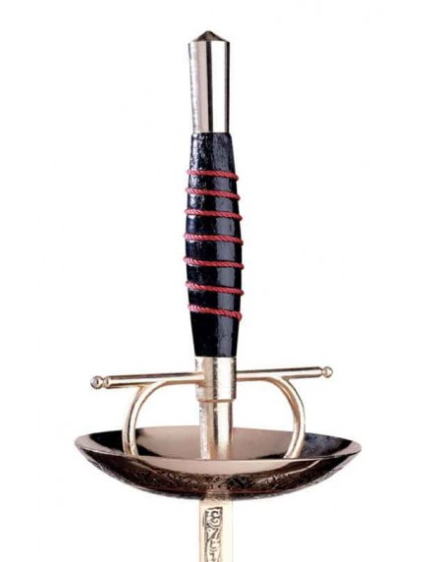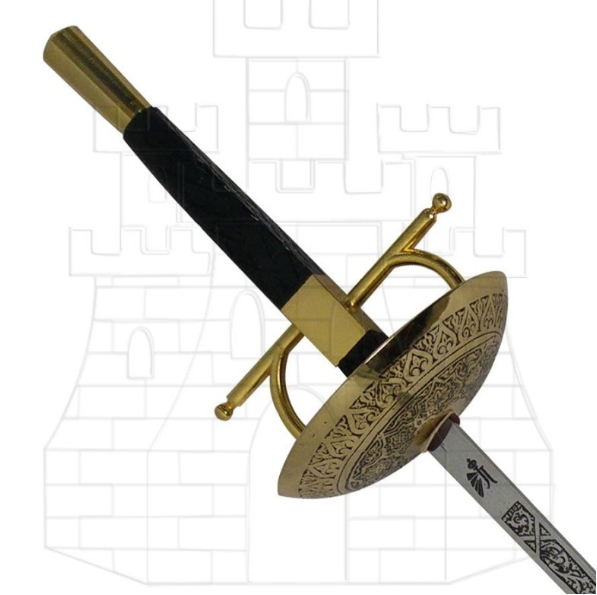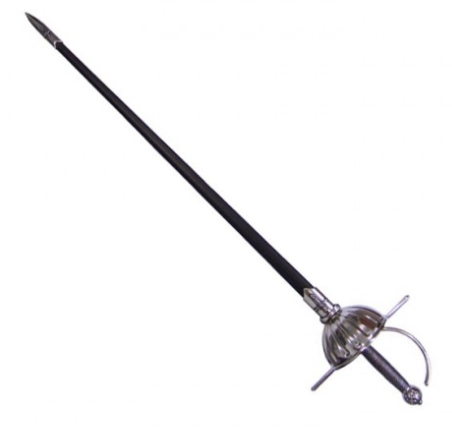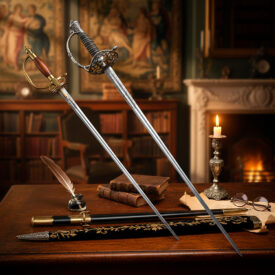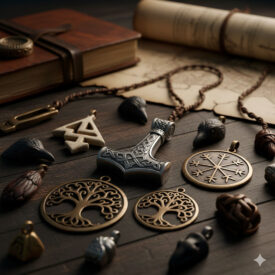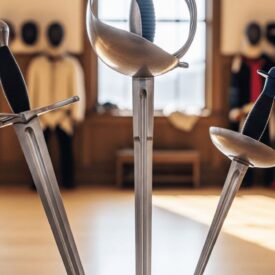Legend has it that in the 17th-century fencing salons, a flower was placed on the tip of a sword to transform blood and fury into a game of precision; from that subtle gesture the foil was born, an weapon that today symbolizes the elegance and technique of sport fencing. If you are passionate about history, the mechanics of the weapon, or want to understand why a touch to the bib lights up a light, here is a deep and evocative guide on the parts of the foil and its evolution until it became the precision tool we know.
Essential history of the foil
The history of the foil is a journey between tradition and science, where each century left its mark on the form and use of the weapon. This chronology summarizes the key milestones that explain why the modern foil is so technical and regulated.
- 15th Century (1473): In Spain, the first known treatise on the handling of combat weapons, El Manejo de las Armas de Combate by Maestro Don Pedro de la Torre, appeared, establishing the foundations of the art of the sword in the peninsula.
- 17th Century: The foil was born as a harmless training weapon with a tip topped with a flower-shaped button to simulate duels without injury.
- 18th–19th Centuries: Development of fencing schools and diversity of grips (Italian, French, orthopedic), with national regulations seeking to homogenize techniques.
- Late 19th Century: Modern fencing consolidated as a regulated sport; measures were standardized and the foil began its transition towards sporting use.
- First Modern Olympic Games (1896): Fencing has been part of the Olympic program since the first editions, reinforcing its international regulation.
- 20th Century: The incorporation of electronic systems and international regulation (FIE) professionalized the foil; weight, length, and electrical parameters limits were defined.
- Mid-20th Century (1956): The electric foil became the standard for Olympic competition, integrating tips with mechanisms and wiring that accurately record touches.
- Present Day: Advanced materials and detailed regulations (blade flexibility, electrical resistance, bell guard dimensions, and lamé) ensure safety and fairness in competition.
Anatomy of the foil: parts, names and technical function
The foil may appear to be a single metallic piece, but it is an assembly of elements designed for safety, ergonomics, and precision. Here we present each component with its purpose and the most relevant specifications according to current regulations.
Blade
The blade is the heart of the foil: long, flexible, and with a rectangular cross-section. Its ability to bend on impact reduces the risk of injury and allows the tip to register the touch without cutting. Usual measurements are a maximum total length of the weapon of 110 cm and a total weight of less than 500 grams, parameters that affect balance and maneuverability.
The blade is divided into two technical zones: the forte (the third closest to the bell guard, more rigid and used for parries) and the foible (the two-thirds closest to the tip, more flexible for precise thrusts). Inside is housed the tang, a metallic part that passes through the grip and is fixed to the pommel, ensuring the integrity of the assembly.
Tip (electric point)
In the modern foil, the tip is not just an end; it is a measuring mechanism. It consists of a spring-loaded button, a plunger, and a barrel that act as a switch. At rest, the circuit is closed; when the tip is pressed against the valid target, the circuit opens and the scoring apparatus records the touch.
It is critical that the tip has the correct mechanical properties: the spring must offer minimum pressure to avoid false positives and the activation travel is usually millimetric. The tip must be approved by the FIE and its insulation in the first few centimeters of the blade is mandatory to prevent accidental contact.
Bell guard
The bell guard, or guard, is the metal cup that protects the hand. In foil, its function is twofold: physical defense and housing for the electrical system. It must be completely metallic, with a convex surface and no sharp edges that could trap the opponent’s tip.
Inside, the bell guard usually has padding or felt that cushions blows and protects the wiring. Under the bell guard is the foil’s socket, the connection point for the body cord that carries the signal to the scoring apparatus.
Grip and pommel
The grip is the interface between the fencer and the weapon. There are multiple designs: traditional grips (Italian, French, Spanish) and modern ergonomic grips (pistol grip and orthopedic). Each design offers different tactical advantages: some favor quick changes of hand and others offer greater stability in the execution of cuts and thrusts.
The pommel, located at the back, secures the grip to the tang. Together with the nut and internal weights, it allows the foil’s balance to be adjusted. Regulations limit elements that can increase hand protection beyond the bell guard, so grips must be clean in their design and fully insulated in the case of electric weapons.
Socket and electric wire
Under the bell guard is the socket that connects the internal wiring of the blade to the body cord. There are two common systems: the bayonet-type socket (a single pin that screws on) and the two-pin socket with a clip. Whatever the system, it must ensure a secure connection and offer protection against accidental disconnections during the bout.
Nut, weight, and balance adjustment
The nut and small internal weights allow the foil’s balance to be calibrated. A balanced weapon improves speed and stability in attacks and defenses. Modern luthiers adjust the assembly so that the feel in the hand is harmonious without exceeding the regulatory weight limit.
Models, variants and aesthetics: from classic to modern foil
Foil models have transitioned from classic elegance to sporting efficiency. There are historical replicas that revive traditional grips and decorations, and technical foils designed for competition with ergonomic grips and optimized internal wiring.
Among the variants, training foils with softer tips, competition foils approved by the FIE, and ornamental replicas that recall historical eras stand out. Each variant responds to an intention: teaching, competition, or exhibition.
Electrical system and conducting equipment: how a touch is recorded
The modern foil is integrated into a circuit that includes the weapon, the body cord, the conducting jacket (lamé), the mask with a conducting bib (in foil the chin can be a valid area), and the scoring apparatus. Understanding this system is understanding the technical magic by which a point becomes visible in a light.
Body cord
The body cord connects the foil to the scoring apparatus by passing through the jacket. It must have conductors with low resistance and ends designed for specific positions; its proper insulation prevents erroneous recordings and protects the electrical signal.
Conducting jacket (lamé) and mask
The lamé is a conductive surface that covers the valid target area in foil: the torso. In competitions, touches to this area light up the corresponding light on the apparatus. The foil mask incorporates a conducting bib that allows touches to the throat and chin to be recorded when connected to the system.
Scoring apparatus
The apparatus receives signals and decides the validity of the touch, managing priority, double-touch blocking, and visual and audible signaling. Its programming and calibration are standard to ensure fairness in the bout.
Comparison table: key technical specifications
| Component | Main Function | FIE Specification / Range |
|---|---|---|
| Blade | Thrust and bend on impact | Maximum weapon length 110 cm; total weight < 500 g; maximum curvature 1 cm |
| Tip | Record touches | Very small activation travel; resistance ≤ 2 ohms; spring with required minimum pressure |
| Bell guard | Protect hand and house socket | Completely metallic; 5.5–9.5 cm in central part (depending on models) |
| Body cord | Transmit signal to apparatus | Resistance per conductor ≤ 1 ohm; specific connectors |
| Jacket (lamé) | Delimit valid area | Surface resistance ≤ 5 ohms between conductive points |
Grips and handling style: practical comparison
The choice of grip influences tactics and ergonomics. The following table summarizes the advantages and limitations of the most common types.
| Type | Advantages | Limitations |
|---|---|---|
| French | Easy to learn; good classic feel | Less ergonomic for quick hand changes |
| Italian | Traditional and simple control | Rarely used in modern competition |
| Orthopedic | Fixed hand position; precision advantages | Reduces versatility of movements |
| Pistol (ergonomic) | Greater control and power in thrusts; adapts to hand | Different learning curve; preferred by advanced fencers |
Practical workshop: maintenance and checks before the bout
A well-maintained foil performs better and avoids problems in competition. These are checks and care you should perform regularly to maintain accuracy and safety.
- Visual inspection: Check that the blade has no significant deformations; a curvature greater than 1 cm can invalidate the weapon in technical control.
- Tip check: Ensure that the button operates correctly, that there is no excessive play, and that the screws are tightly secured.
- Wiring review: Check the integrity of the insulated wire in the upper groove of the blade; damaged insulation can cause electrical failures.
- Socket and body cord test: Connect and observe signal transmission; replace worn connectors.
- Cleaning and lubrication: Prevent corrosion; dry the weapon after use and apply appropriate products to moving metal points, without affecting insulation.
How the parts of the foil influence technique and strategy
Every detail of the foil dictates a type of fencing. A blade with greater flexibility conditions the line of attack; an ergonomic grip allows varying rhythm and distance; a calibrated tip demands millimetric precision. Fencing masters teach that knowing the weapon is as important as knowing the opponent: only then does strategy become predictable and accurate.
Speed and precision
The lightness and balance of the foil prioritize speed. In rapid exchanges, the blade must respond with immediate return, and the tip must only register clear impacts; that is why the spring configuration and the cleanliness of the electrical system make the difference between a valid touch and a lost opportunity.
Defense and distance control
The bell guard and the forte of the blade allow parries and defensive actions that transform defense into attack. A well-balanced foil helps maintain distance and execute feints that seek to provoke errors in the opponent.
Recovering history: historical foils and replicas
Historical replicas evoke the aesthetics of the 17th–19th centuries: ornate grips, decorative scabbards, and blades that recall campaigns and duels. They maintain the essence of classic handling, although for current sports practice it is mandatory to adapt or use homologated foils in competitions.
What does knowing the parts of the foil mean for the fencer?
Knowing a foil in depth transforms the fencer: they cease to be a mere executor of techniques and become an artisan of action. Knowing how to adjust the balance, how to verify a tip, or how to interpret the behavior of the blade when an opponent parries allows for more intelligent tactical decisions in milliseconds.
Mastery of the weapon also builds confidence: a fencer who has learned to regulate their foil knows that every touch has a technical cause and can correct it with precision.
Visual resources and featured pieces
The images distributed throughout this text show details of the foil and some models that illustrate the variety of grips and bell guards. Observe the position of the socket under the bell guard, the groove for the electrical wire in the blade, and the ergonomics of the grips to better understand how each choice impacts practice.
Mastering the parts of the foil is not just about memorizing names; it is about understanding how each piece participates in a dialogue between technique, regulation, and tactical intention. From the tip that lights up a light to the grip that defines the ergonomics of the gesture, each element tells a story.
SEE MORE FOILS | SEE SABERS | SEE RAPIERS WITH LOOP HILTS | SEE RAPIERS WITH CUP HILTS

